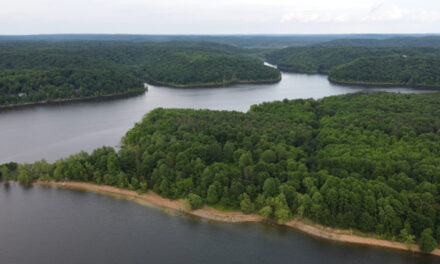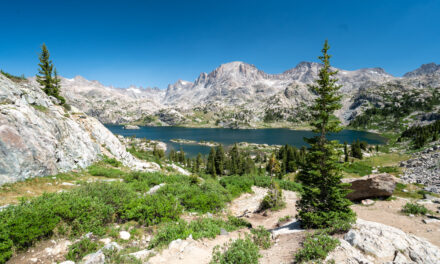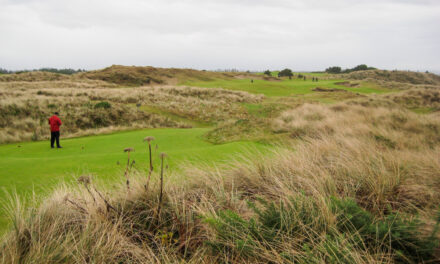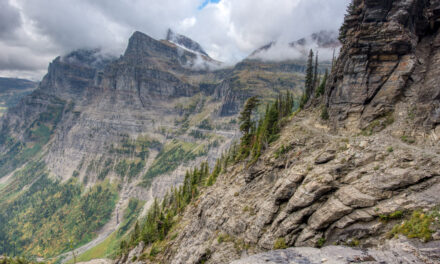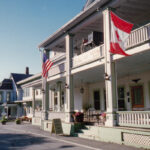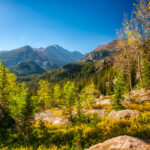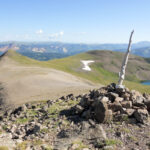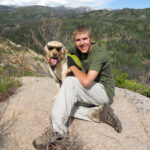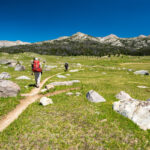Adirondack High Peaks Wilderness (NY) Backpacking – June 2020
Adirondack High Peaks Wilderness – June 2020
25
JUNE, 2020
Following up on my May 2020 Cranberry Wilderness hike, during the peak of the Covid-19 pandemic, June 2020, a group of us ‘escaped’ from lockdown to take a much-needed backpacking trip in the Adirondack High Peaks Wilderness. I had no business being on this hike, frankly! Because Jeremy thoroughly planned the hike, I hadn’t done adequate homework. I had no idea what I was in for. This was the most demanding hike I had ever attempted. When I returned from the hike, I finally did a little homework. Multiple experts labeled the High Peaks Traverse hike ‘the hardest hike in North America.’
Background – Memories of Lake Placid
My Grandparents lived in New York, near West Point in the Catskills. When we would visit them, my Dad and Grandpa would talk fondly about family camping trips to the Adirondacks. Some of those trips for my Grandpa were going back to the 1930s. The Lake Placid Winter Olympics took place in 1980 when I was 19. I remember being glued to the TV as Jim McKay hosted the nightly broadcasts. The snow-covered street scenes of idyllic Lake Placid were in the window behind him. It was a memorable and magical Olympics. As a result of those memories, a hike in the Adirondacks, specifically a visit to Lake Placid, had always been on my bucket list. The opportunity presented itself just after the peak of Covid in June 2020. Jeremy had a trip planned, invited me, and I decided to join them.
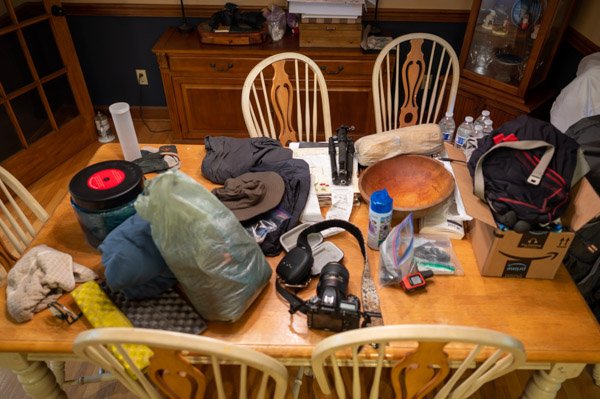
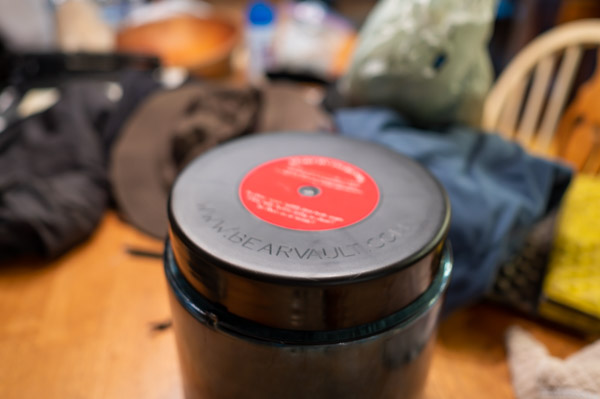
Two trips in one – hiking and history
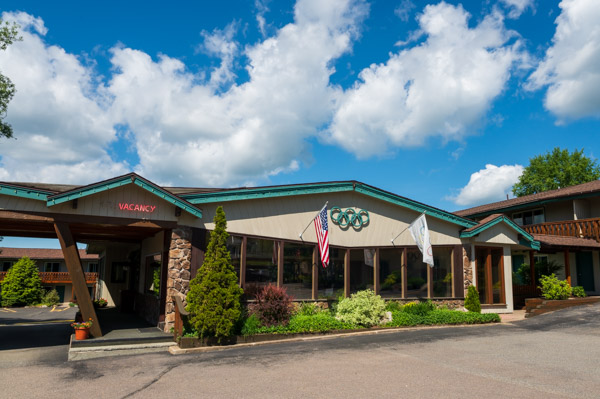

The trip was two trips: (1) exploration of Lake Placid and the 1980 Olympic sites and history, and (2) a backpacking trip in the Adirondack High Peaks Wilderness. I planned to start the 13.5-hour drive to Lake Placid relatively early to accomplish my first objective. I’d sleep briefly in my car at a rest area and arrive in Lake Placid many hours before the rest of the group. That would allow time to do touristy stuff and see the sights in Lake Placid. After some research, I decided upon Art Devlin’s Olympic Motor Inn as our lodging for the night. It turned out to be an excellent choice. Art Devlin was an Olympian and played a significant role in bringing the Winter Games to Lake Placid in 1980. The place oozed history, and I loved it!
Visiting 1980 Winter Olympic sites in Lake Placid
After getting settled in at the Olympic Motor Inn, I decided to head out and explore. It was still mid-morning, and I had many hours before the rest of the crew would arrive. My plan was to first check out the many local Olympic venues from the 1980 Winter Olympics. After sightseeing, I’d check out the High Peaks Wilderness South Meadow trailhead. The South Meadow trailhead is where we would start our hike the next day. I wanted to check out the parking situation since we would have at least four cars to deal with.
I visited the ice arena where the ‘Miracle on Ice’ happened. That is where the USA team won the gold medal in hockey, against all odds. They made a movie about it, ‘Miracle on Ice.’ I walked on the outdoor speed skating track grounds where Eric Heiden won 5 gold medals in speed skating. Heiden set four Olympic records and one world record in the process. The ski jumping hill south of Lake Placid was next on the schedule. I then drove up the mountain to visit the Whiteface Mountain Ski Resort, where the downhill skiing events took place. Sadly, every venue was closed to visitation due to recently imposed Covid restrictions. My only views were from a distance.
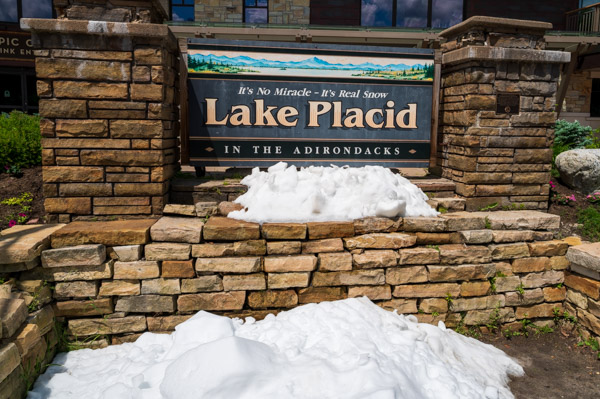
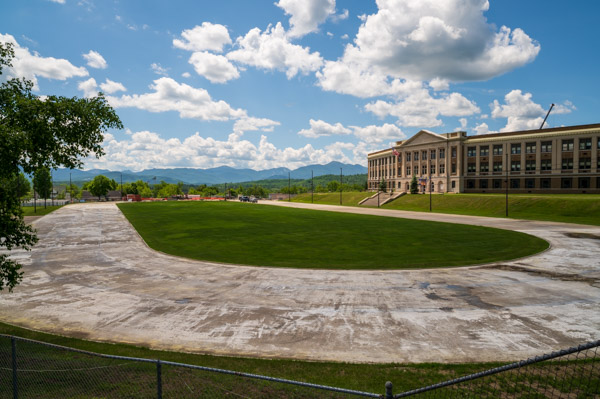
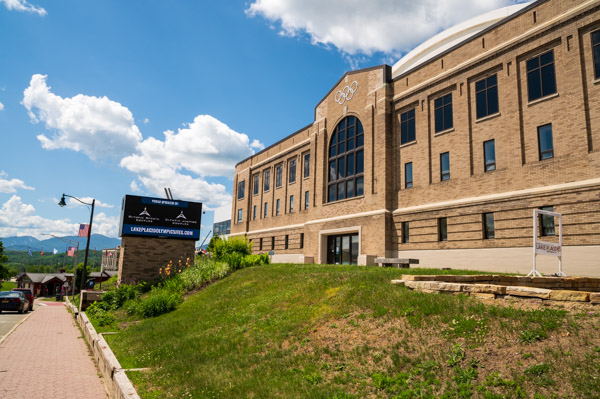

South Meadow Trailhead – High Peaks Wilderness
The High Peaks Wilderness South Meadow trailhead wasn’t far off my route coming down from Whiteface Mountain. So I headed out to see it and understand the parking situation. Fortunately, there was more than ample parking. My concern about not finding parking spaces was alleviated. I also learned that there were a ton of nice ‘dispersed’ (free, open to anyone) campsites nestled in the trees. Sites were located along the drive from the main road to the trailhead. Those campsites would be an excellent (and free) staging area for a hike in the High Peaks Wilderness if one were so inclined.
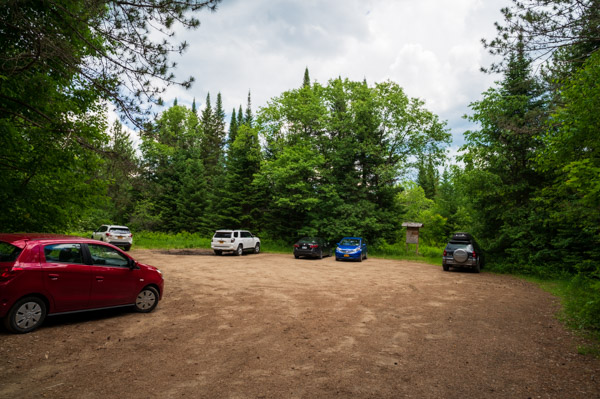

Night before the hike in Lake Placid
The rest of the hiking crew arrived in the late afternoon. After they checked in, we decided to walk to some pubs and restaurants in the area. It wasn’t clear what the Covid rules would be like or whether we could even get some food and beer. Unfortunately, Covid restrictions were in full swing during our visit. Lake Placid opened up limited outdoor dining, in some locations, that same day.
Jason was able to find a small pub by the Olympic Motor Inn that had tables set up in the parking lot. It certainly wasn’t glamorous, but we ordered pizzas and some beer. The dinner was a little weird but fun.

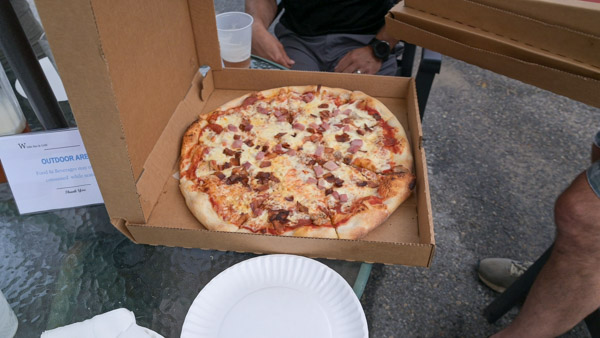

The night ended by the pool, watching the mountains and the thunderstorms rolling in. A healthy downpour eventually developed and chased us to our rooms. It had been a wonderful first day. With the travel and touristy exploration completed, we were ready for some hiking the next day.
First day hiking in the Adirondack High Peaks Wilderness
Breakfast, last-minute gear preparation, and drone flying
The morning rituals and chores were completed and the packs and cars loaded. We headed to the Motor Inn lounge area for a complimentary spartan breakfast. The menu was prefab pastries, bagels, muffins, coffee, and a dose of Olympic history. The trophy case in the Art Devlin Motor Inn lounge is something to behold. After breakfast and our Lake Placid Olympic history lesson, the caravan traveled to the South Meadows trailhead. We passed by the ski jumping hill. Jason decided to capture a little drone footage of the ski jump hills. He would use it to introduce his High Peaks Wilderness YouTube video of our hike. He flew the DJI Mavic Mini. I was blown away by the small size of the drone and the video quality. Very cool!
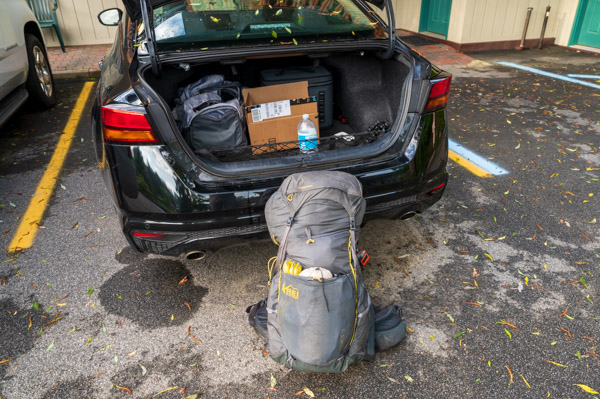

Starting the hike on the Klondike Notch Trail
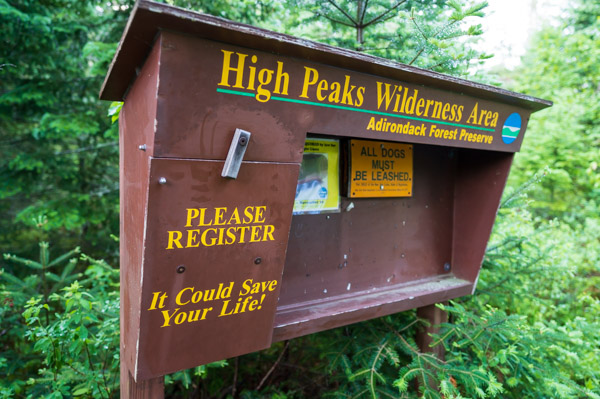
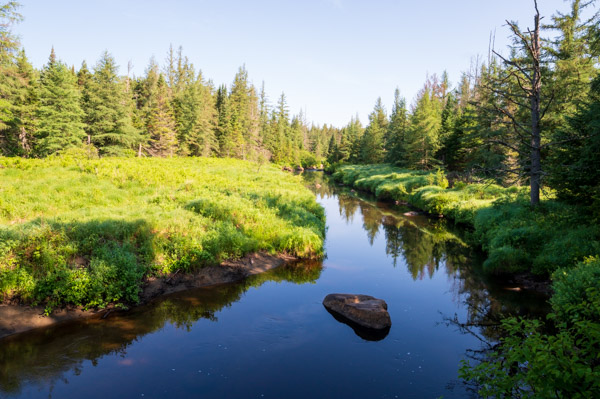
The hike began on the Klondike Notch Trail after filling out the High Peaks Wilderness self-registration permit at the South Meadow trailhead kiosk. It was a relatively gentle and easy trail, passing over multiple streams and through peaceful meadows. The pleasant hiking did not indicate what would come later on the first day, and especially the next day. The weather was significantly warmer (the upper 70s) and more humid than expected. The conditions were suffocating when combined with the dense tree canopy overhead. The dense leaf cover contained the heat and humidity and prevented any wind from cooling things off. My lack of proper training and conditioning made me question what I had gotten myself into.
The Klondike Notch Trail to the Ranger Station
The High Peaks Wilderness hike on the Klondike Notch Trail continued uphill, gradually getting steeper. We walked along and over various streams through a relatively dense northern-type forest with a mix of conifers and deciduous trees. It was a lovely setting, much different than I am exposed to in the Midwest. About 2.5 miles into the hike, we came to the Klondike Notch Lean-to (a.k.a. shelter). The shelter sits along a stream in a pleasant forest setting along the south side of the trail. It would be the perfect destination for a quick overnight trip launching from the South Meadow Trailhead.
It was empty when we passed it, but I’m guessing it gets a lot of use. In another 1.5 miles, we came to the intersection with the Yard Mountain Trail. Even the trail intersection signs looked cool! Some rain started falling as we descended after reaching the top of the long climb out of the trailhead. The precipitation only increased the humidity in the dense forest setting. With the mid-70s temperatures, it started to feel like a sauna. But what a gorgeous backdrop for a steam bath! At about 5 miles, we crossed a large bridge and entered a prominent area of significant civilization. It turned out to be a Ranger Station at the base of the hill, which was also the start of the Wolf Jaw Trail.
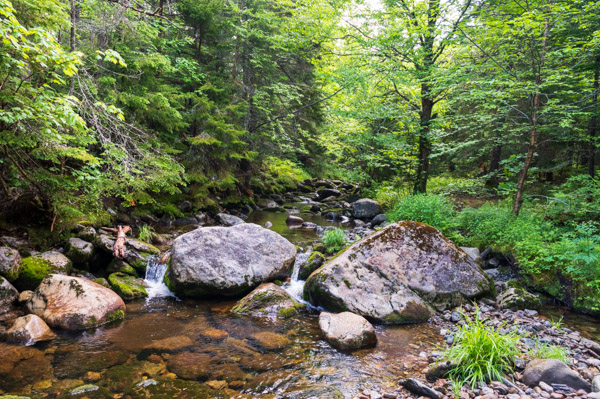

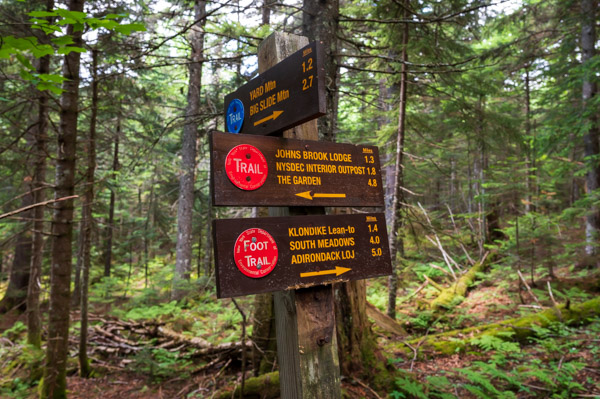
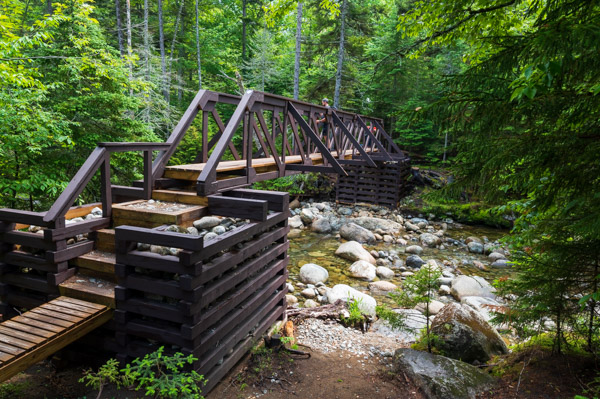
Lunch at the Ranger Station
We hoped that we might be able to obtain some ‘real’ food, snacks, and drinks for lunch at the Ranger Station, but it was closed, likely a victim of Covid restrictions. With the rain still falling, we decided to take advantage of the covered porch of the Ranger Station to take a break and grab some lunch. It was a pleasant and much-needed break – certainly for me! A couple of people broke out the stoves for a hot meal. Others – like me – made do with cold snacks, tortilla wraps, energy bars, and homemade trail mix. It was interesting and informative to see the wide range of mid-day food items that everyone consumed. After lunch, we started the climb up the Wolf Jaw Trail.
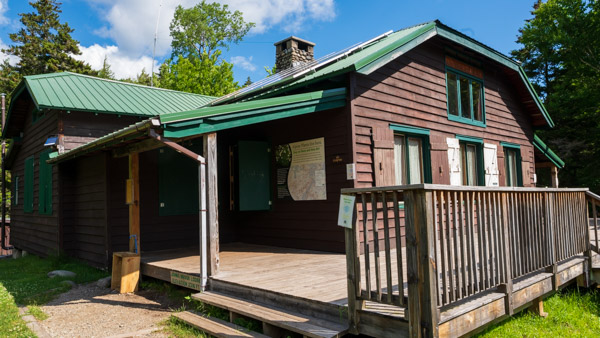
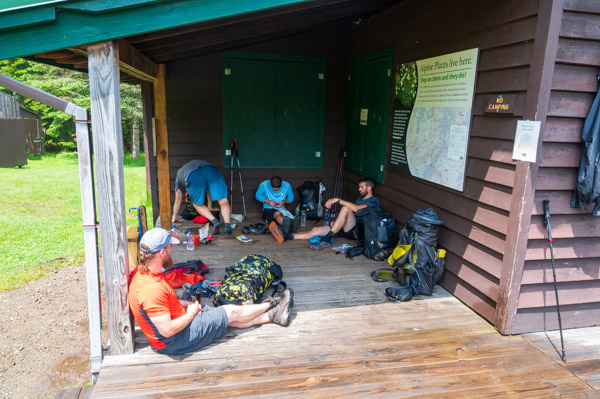
Ranger Station to the Wolf Jaw Lean-to
As we got started after lunch, right on cue, the rain ended, and the skies turned sunny. It was steeply uphill the remaining 1.5 miles to the Wolf Jaw Lean-to. But now, we were rested and re-filled with calories and hydration. It was a quick, pleasant stroll to our first night’s camp in the High Peaks Wilderness. The lean-to wasn’t large, and there was already another couple staying there when we showed up. Many in our group decided to set up tents and hammocks. There weren’t many/any good, level tent sites, so some creativity was required. But everyone found a spot.
I decided to stay in the shelter, which proved a good call since it ended up raining hard all night. A family of mice entertained us, with Momma deciding to re-locate all of her many babies from one side of the shelter to the other. Water was found at a nearly-dry stream 1/4 mile from the shelter. We spent a pleasant evening having dinner, watching mice, and reading entries from the lean-to journal. The next day would mark the ‘real’ beginning of the hike, the steep ascent to Lower Wolf Jaw.

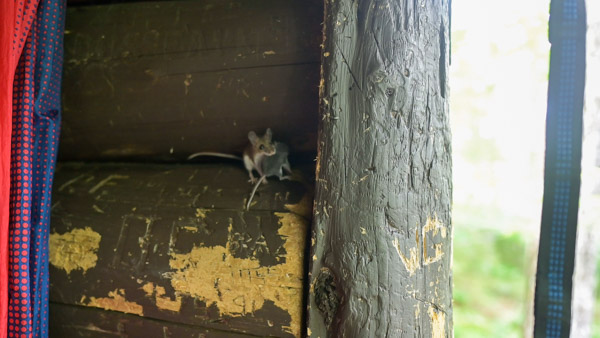

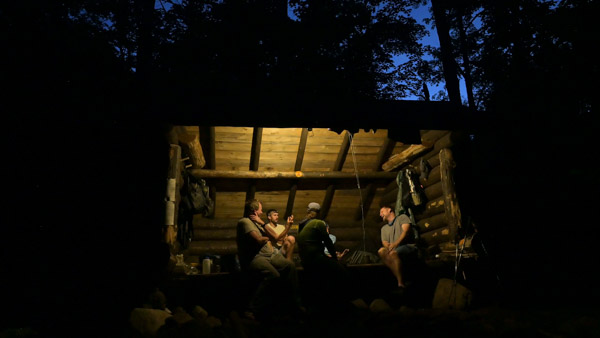
Second day hiking in the Adirondack High Peaks Wilderness
An Adirondack eye-opener – Wolf Jaw Trail to Lower Wolf Jaw

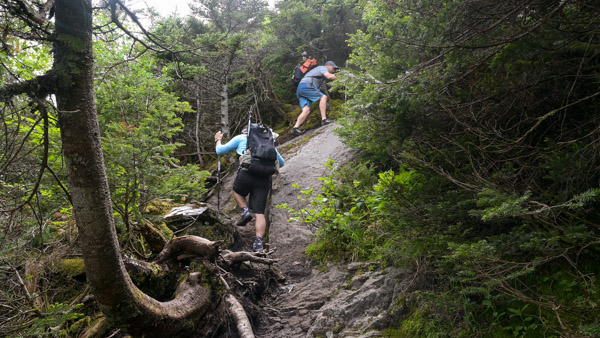
It didn’t take long to realize that the climb to Wolf Jaw would be no joke. The climb started steeply uphill from the lean-to and progressively got steeper. The ‘trail’ became more of a Ninja Warrior course than a trail. The effort required was as much an upper body exercise as any leg exertion. With heavy packs, mine certainly being the heaviest of the group, it was brutal and exhausting. Jeremy came prepared – his tiny pack looked like a day pack! I hadn’t counted on what the ‘trail’ conditions would do to our hiking pace. The rugged trails dramatically slowed our pace. I had only carried 2 liters of water up the hill in my typical fashion. Given the slow pace, that was not going to be nearly enough.
The summit of Lower Wolf Jaw and questioning my ability to finish
The summit of Lower Wolf Jaw was reached 0.5 miles after starting the final climb. It took us a bit over an hour to complete that half mile! The surrounding High Peaks Wilderness view was spectacular and made the effort worthwhile. We stopped to get a much-needed rest break, absorb the view, and grab a snack. It was starting to dawn on me that I’d gotten into something that was a bit over my head, and the lack of water situation was beginning to worry me. I had hoped to come upon some streams, but there was no water, not surprising given the steep ridge we were hiking on. There was no thought of turning back. But, for the first time, I was starting to question whether I would physically be able to complete a hike.
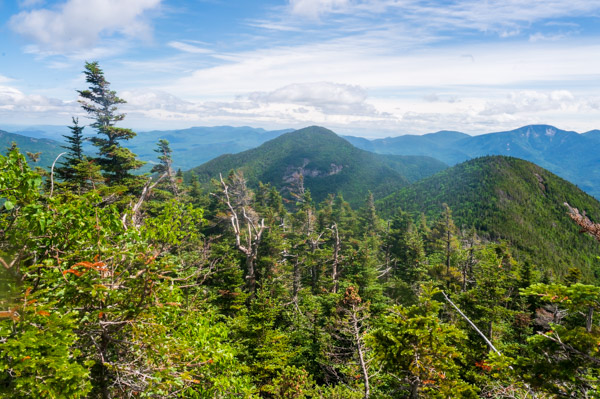

Summiting Armstrong Mountain
I pressed on. If anything, trail conditions only got more arduous, and there were no breaks from the jungle-gym type hiking. We learned that most people take on the High Peaks Traverse as a day hike with no packs or minimal day packs. As a day hike, I could see how it would be a blast. It was fun to figure out how to navigate the many ‘obstacles’ we came across. But with no water, exhausted from the effort, and no bailout points, my anxiety rose with each step forward. There was no choice but to press on. After Wolf Jaw, we made it over Armstrong Mountain and headed towards The Gothics.
Refreshing lunch and The Gothics
At the saddle between Armstrong and the Gothics, we stopped for lunch. The rest of our hiking crew had graciously given me a little of their water. I was thankful beyond words, but it made me feel like ‘that guy’ and lower than whale dung. They needed the water as badly as I did. But the infusion of calories, water, and electrolytes gave a much-needed energy and mood boost. There was a sign at our lunch spot that indicated the summit of the Gothics was 0.5 miles away. As I stared up at the Gothics, it looked more like 5 miles to me. I now realized that 0.5 miles would take us over an hour to complete.
Our pace along the High Peaks Traverse stretch of trail had been consistently under 0.5MPH. The three miles of hiking we did along that stretch took us 7 hours to complete! Perhaps if I was mentally (and physically) prepared to take something like that on and had packed adequate water, it wouldn’t have phased me. But with no water and not realizing what we faced, it was mentally pretty brutal. I decided to take the first bail option.

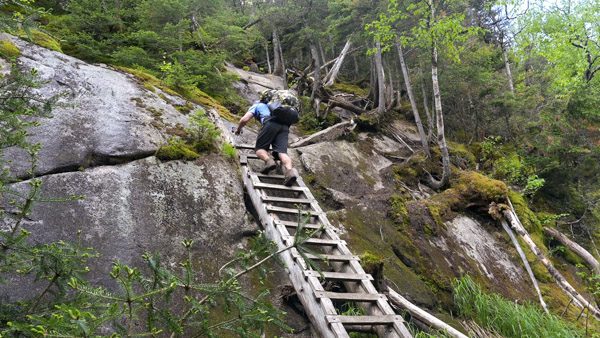

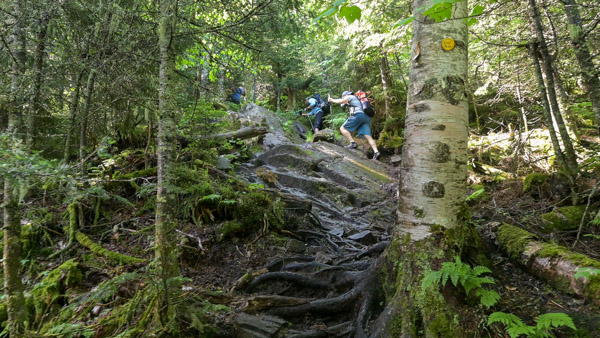
The summit of The Gothics and decided to end the hike early


We made it to the summit of The Gothics after successfully navigating some of the steepest, most challenging trail encountered up to that point. The view was spectacular, with a 360-degree panorama stretching out as far as the eye could see. It was breathtaking to look out at the peaks surrounding us. It gave me a sense of accomplishment to look back at the section of the trail we had completed. I felt pride in having made it, but, given the circumstances, I decided to bail out. The bailout route descended on the Orebed Brook Trail down to the Orebed Brook Lean-to. I would stay in the Orebed Lean-to the last night. There were strong winds on the summit, and temperatures were cooling fast, so we grabbed a group photo and moved on.
Descent from The Gothics
The descent southbound off The Gothics is epic and legendary. It is also EXTREMELY steep. Adding to the ‘fun’ is the view of the bottom of the rock face, which serves as the ‘trail’ – there is a cliff right at the base of the descent, which sends a clear message that any misstep will have significant consequences.

Multiple techniques were employed to (hopefully) safely make it down. Jeremy used the low profile, butt-skootch approach. I chose to stay more upright and go into ‘super-sticky’ mode. The idea was to keep every possible bit of Altra Lone Peak sole surface area glued to the rock. My ‘steps’ were about an inch at a time. I have to admit that the descent was pretty fun. I’ve never experienced anything remotely like that, and adding to the enjoyment were breathtaking views in all directions. After the initial descent, it got a bit steeper. But in the steepest of the stretches, they had installed cables to assist you in making it down safely. It felt like rappelling down a cliff face… because that is effectively what we were doing.

Torn Meniscus

At the base of the descent, we reached the intersection with the Orebed Brook Trail, where I decided to make a right turn and bail down to the lean-to. I planned to hike out solo, but everyone but Jason decided to join me in the end. The trail descended steeply but slightly less so than from The Gothics. We reached a point where the rockface was wet and with more vegetation.
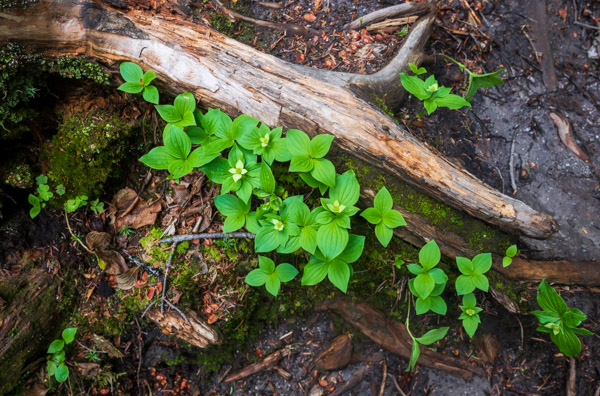

At one point, I slipped and rolled down the face about four rotations. I came to rest on my backpack like a turtle. Amazingly, no harm was done. Unfortunately, I think I was in shock from the fall. About 100 yards further down, my lower foot slipped out. I went into an elongated ‘hurdler’s stretch’ with all the pack weight straining my knee. That slip cost me 60% of my left meniscus! (Yep, I tore my meniscus). Fortunately, I was still able to walk. The trail gradually leveled out. The remaining 1.5 miles to the lean-to along Orebed Brook were ‘primordial,’ overwhelmingly green, and beautiful. I used the lean-to’s ‘privy with a view’ to strike a pose of Rodin’s ‘The Thinker’ the following morning.
Conclusion – Adirondack High Peaks Wilderness
Despite the hike’s difficulty, I am happy that I did it. And though I’m not an advocate of going into a hike oblivious to the trail conditions, being unprepared was likely a ‘blessing.’ If I had known what I was getting into, I’m quite certain I wouldn’t have attempted the hike. Though that was probably the wisest call, it would have left me somewhat deflated and disappointed that I wasn’t ‘up to the challenge.’ Remarkably, I completed the hike without issue with my knee injury. I knew something was wrong with the knee, but there was little pain and no swelling. I had no idea the meniscus was torn.
But about two weeks after the hike, a piece of the torn meniscus somehow migrated into the joint of my knee. I experienced pain worse than anything I’d felt before. The pain immediately forced me to the ground and nearly caused me to blackout. Worse, I couldn’t straighten my leg. As I went through all the medical processes to get the knee repaired for the next two months, I couldn’t walk more than a few feet. Sleeping was tough because my knee would straighten as I slept, causing great pain and waking me up (constantly). It was a rough couple of months. In late August 2020, I had the surgery to repair the knee and immediately was able to walk normally again.
Adirondack High Peaks Wilderness – most difficult hike
It is said that the High Peaks Traverse in the High Peaks Wilderness is the most difficult blazed hike that you can attempt in North America. Having now hiked a decent chunk of it, I wouldn’t argue with that assessment. I have done many challenging hikes during my backpacking days (Four Pass Loop, Glacier, and many others in Colorado). Still, nothing comes even remotely close to that hike in terms of difficulty. When asked, I’ve described the Hike Peaks Traverse as more of a Ninja Warrior course than a hiking trail. But for anyone looking for a unique challenge in a gorgeous area of our country, I can certainly recommend the High Peaks Traverse as an adventure that will provide a suitable challenge.
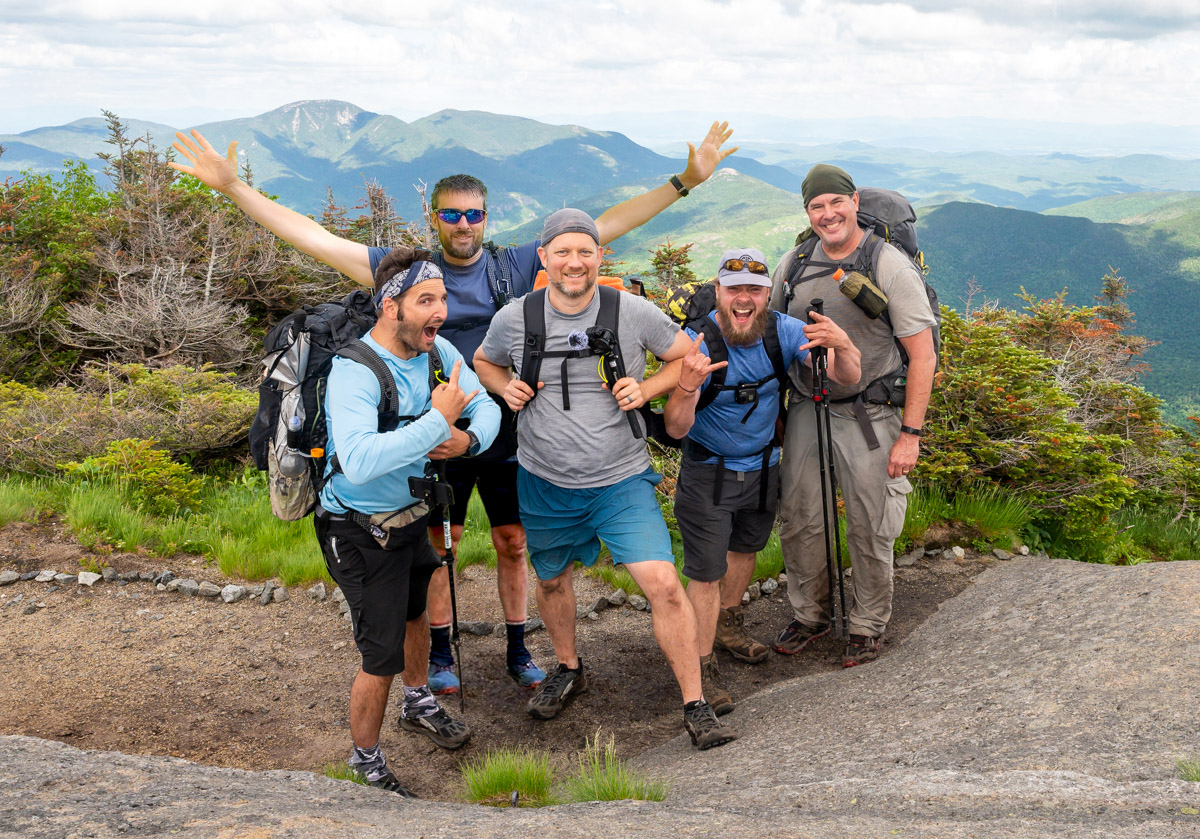
Group shot on the summit of The Gothics
